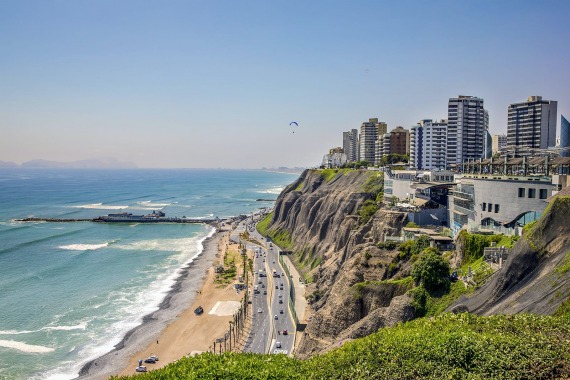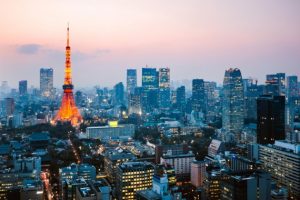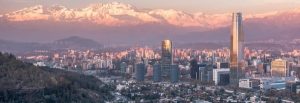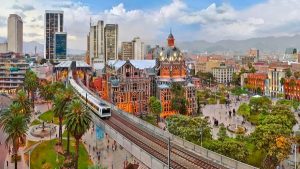Lima is the capital and the largest city of Peru. It is located in the Chillón, Rímac, and Lurín Rivers valleys in the central coastal part of the country, overlooking the Pacific Ocean. Together with the seaport of Callao, it forms a contiguous urban area known as the Lima Metropolitan Area. With a population of more than 9 million, Lima is the second-largest city in the Americas, after São Paulo.
Warnings & Dangers in Lima

OVERALL RISK : MEDIUM
In Lima, tourists need to keep track of their wallets and belongings. Serious crimes against tourists are rare here, but there are quite a few petty thefts. Be as careful as possible and do not walk around this city late at night.

TRANSPORT & TAXIS RISK : MEDIUM
Public transport is not very safe; tourists are advised to use taxis. Make sure to use only licensed taxi services. Don't catch a taxi from the street. Make sure the driver has turned on the taximeter.

PICKPOCKETS RISK : HIGH
Pickpocketing happens most often in Lima. Tourists need to be especially careful in crowded places, tourist attractions, and at train stations and airports.

NATURAL DISASTERS RISK : MEDIUM
Lima is located in a seismically hazardous area. The city is also prone to landslides and floods. Study the weather conditions before your trip here.

MUGGING RISK : MEDIUM
The risk of serious robbery and armed attacks is not very high in Lima. There is little danger of these attacks in the suburbs. However, the likelihood that you will be attacked is minimal. Avoid communicating with suspicious individuals and not walking late at night in remote areas from the city center.

TERRORISM RISK : MEDIUM
The risk of terrorism exists in Lima, but it is not high. Investigate the political situation before you visit this city.

SCAMS RISK : MEDIUM
Fraud is common in Lima. Usually, the victims are imprudent tourists. The most common types of fraud are selling fake goods and services, overcharging taxi fares, and skimming credit cards. Withdraw money only at ATMs at banks.

WOMEN TRAVELERS RISK : HIGH
Women traveling alone in Lima should be more attentive to their surroundings and not wander around the city late at night. Sometimes women travelers reported that they had been sexually assaulted in Lima, so female travelers need to avoid isolated locations and traveling alone at night.
How Safe Is Lima for Tourists?
Lima is not the safest city to travel to.
The crime index here is at a fairly high level.
The main problems are related to corruption, drug trafficking, vandalism, and theft.
Although Lima has a reputation for being a dangerous city, it is enough to stay away from areas that seem neglected, especially at night.
Consider taking a taxi to avoid walking through more dangerous areas.
Don’t carry a lot of expensive things, devices, and a lot of cash with you.
This will not attract the attention of thieves to you.
While there are few violent crimes against tourists, petty theft is common.
Keep track of your belongings and your surroundings.
Wear anti-theft backpacks and keep your bags in front of you.
If someone is amiable (even wants to shake your hand), ignore them, and they will leave.
It’s okay to find polite people who try to help tourists but stay away from amiable people.
Be careful when crossing the road – pedestrians are often ignored here, even behind pedestrian crossings and green lights.
If you are traveling by car, watch the traffic – local drivers can be very aggressive in driving.
Do I Need a Visa to Visit Lima?
Holders of passports of the following 97 jurisdictions can visit Peru for tourism purposes (unless otherwise stated) without a visa for up to 183 days. A valid passport is a must.
Which Currency Is Used in Lima?
A travel insurance policy is a must when visiting a foreign country or city. Make sure you got it before starting your journey; the customs officer may ask for it.
How's the Weather like in Lima?
In Lima, the summers are warm, muggy, arid, and overcast, and the winters are long, cool, dry, windy, and mostly clear. The best time to visit Lima is from December to April.
What Do I Need to Know about Airports in Lima?
Jorge Chavez International Airport has regular international flights and it is the busiest international airport in Peru. The airport is located in Callao, which is 11 kilometers away from Lima.
Should I Get Travel Insurance for My Travels?
A travel insurance policy is a must when visiting a foreign country or city. Make sure you got it before starting your journey; the customs officer may ask for it.
What Are Some Things to Do in Lima?
Lima, the capital of Peru, lies on the country’s arid Pacific coast. Though its colonial center is preserved, it’s a bustling metropolis and one of South America’s largest cities. It’s home to the Museo Larco collection of pre-Columbian art and the Museo de la Nación, tracing Peru’s ancient civilizations’ history. The Plaza de Armas and the 16th-century cathedral are the heart of old Lima Centro.
Is the Water in Lima Safe to Drink?
Tap water is not drinkable in Lima. You should buy bottled water or boil tap water.
Is Uber Safe in Lima?
There is an Uber taxi in Lima. You can call a taxi from the app on your phone. The cost of the trip will depend on the distance and time of day.




